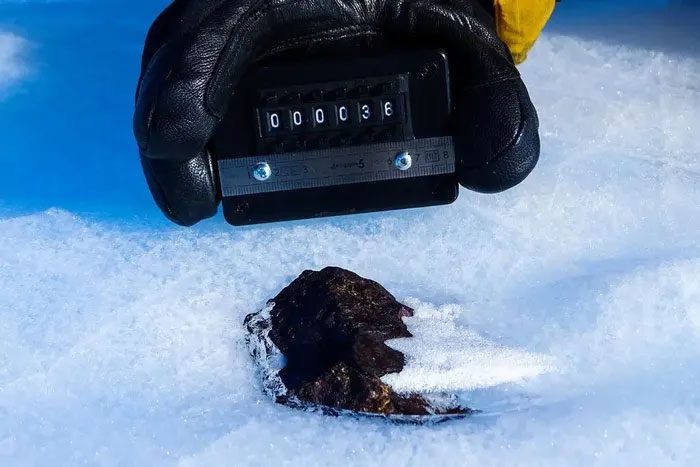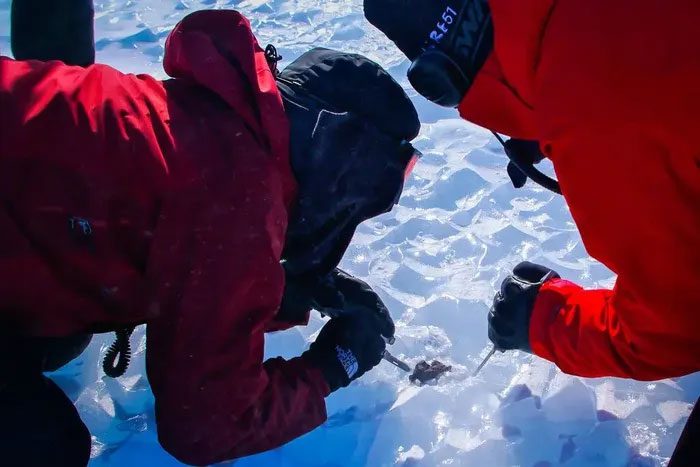Rising temperatures in Antarctica are causing meteoroids – extraterrestrial treasures – to sink before researchers can collect them, according to The New York Times.
One way to search for meteoroids is to quickly head south. Some areas in Antarctica have what appear to be ordinary old rocks, but are actually fragments from asteroids, the Moon, or even Mars. Approximately 60% of known meteoroids have been collected here.
The massive quantity of meteoroids in Antarctica likely does not stem from many extraterrestrial objects falling there, but simply because they are more visible on the Antarctic ice sheet. “It’s super easy to spot a dark rock against the white surface,” said Cari Corrigan, a geologist at the Smithsonian Institution and curator of the meteoroid collection at the National Museum of Natural History (USA).
This continent also has many areas known as blue ice regions. These regions are often located near mountains, with terrain that features layers of compacted ice and strong winds continuously eroding the surface. These are ideal conditions to concentrate the discovery of meteoroids that have fallen thousands of years ago.

A newly recorded specimen. (Photo: Katherine Joy/University of Manchester).
Meteoroids “Hiding”
Scientific investigations into extraterrestrial material to elucidate how the Solar System formed billions of years ago are likely to become more challenging in Antarctica in the coming decades. The reason is that as temperatures rise, thousands of meteoroids sink into the continental ice and vanish from sight each year, according to a new study published on April 8 in Nature Climate Change.
In recent years, researchers have discovered many specimens in Antarctica that are partially frozen rather than lying exposed on the surface.
According to Veronica Tollenaar, one of the lead authors of the article published in Nature Climate Change, most meteoroids have dark surfaces, which are heating up more and melting the ice beneath them.
“Meteoroids will sink. The higher the temperature, the more rapidly the melting process occurs,” Tollenaar and her colleagues stated.
Using a model they developed, the research team estimated the number of visible meteoroids in blue ice regions of Antarctica under various warming scenarios. They found that between 4,000 and 6,000 meteoroids will disappear from view each year over the next few decades. By the end of this century, three-quarters of the meteoroids that once lay on the ice could “hide.”
Harry Zekollari, a glaciologist at ETH Zurich (Switzerland) and Vrije Universiteit Brussel (Belgium), who led the study alongside Tollenaar, noted that metal-rich meteoroids like iron are at the highest risk of disappearing because they conduct heat well, meaning they transfer heat to the surrounding ice more easily.

Researchers found a meteoroid during the 2009-2010 expedition. (Photo: Steven Goderis/Vrije Universiteit Brussel).
“Racing Against Time”
From here, Tollenaar suggests that future Antarctic expeditions to search for meteoroids should prioritize locations at lower elevations. These are also areas that tend to warm and have a higher risk of causing meteoroids to disappear in the coming years.
Many meteoroids in Antarctica are typically found at elevations close to 1,800m to over 2,011m. However, nearly 90% of the meteoroids at that elevation will vanish from view by the end of the 21st century, the research team estimates.
“It is crucial to focus all efforts on the most ‘sensitive’ locations,” Tollenaar said.
Dr. Corrigan, who has made two trips to Antarctica to search for meteoroids, acknowledged the urgency: “We want to get out there and collect as many meteoroids as possible before they disappear.”
According to Dr. Zekollari, technology may be of assistance. Most meteoroids in Antarctica have been found in the traditional way: through networks of hikers or snowmobile drivers. Now, efforts to use technology such as drones to scan the ice are underway.
“We need to be more productive. It’s a race against time,” he expressed.


















































